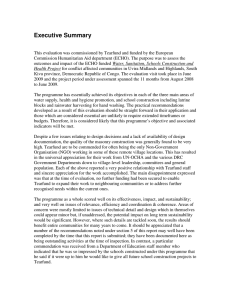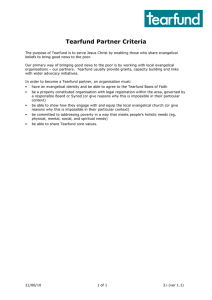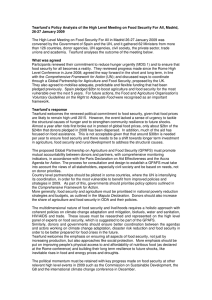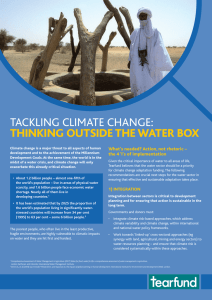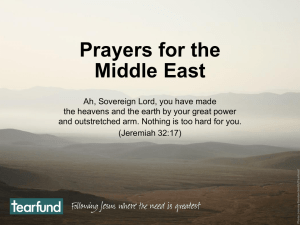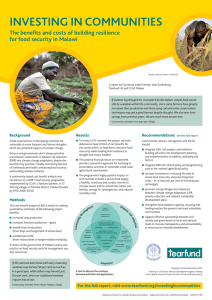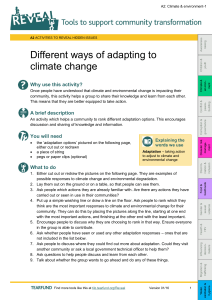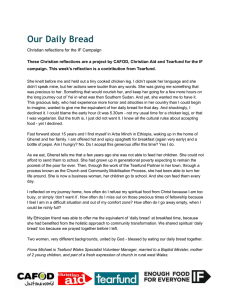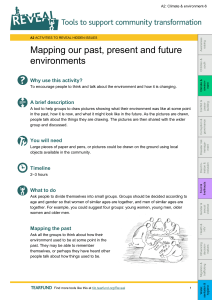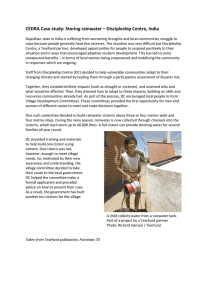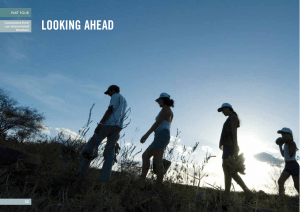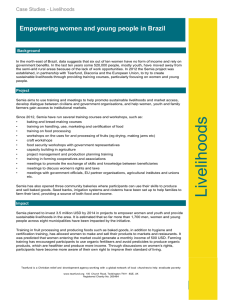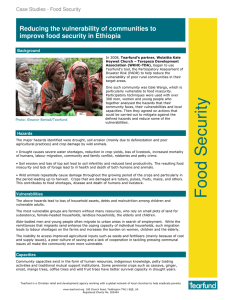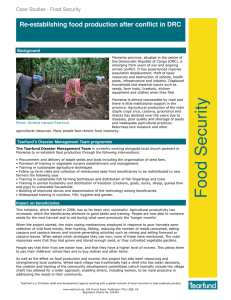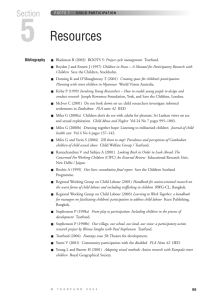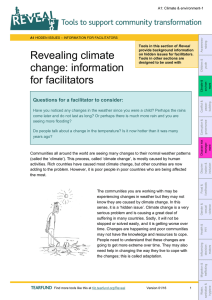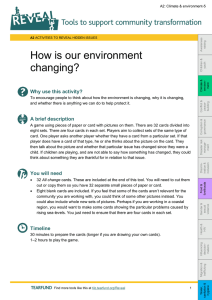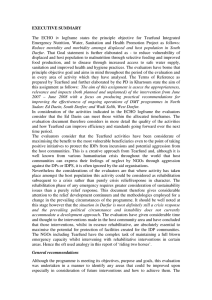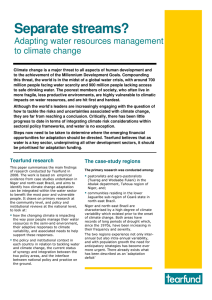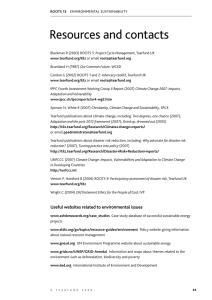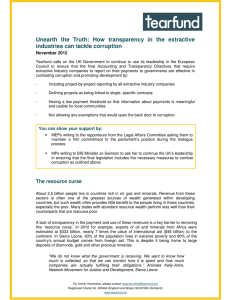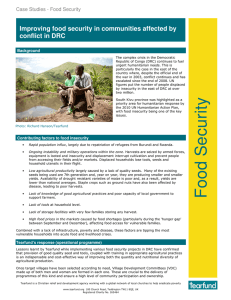Executive Summary
advertisement
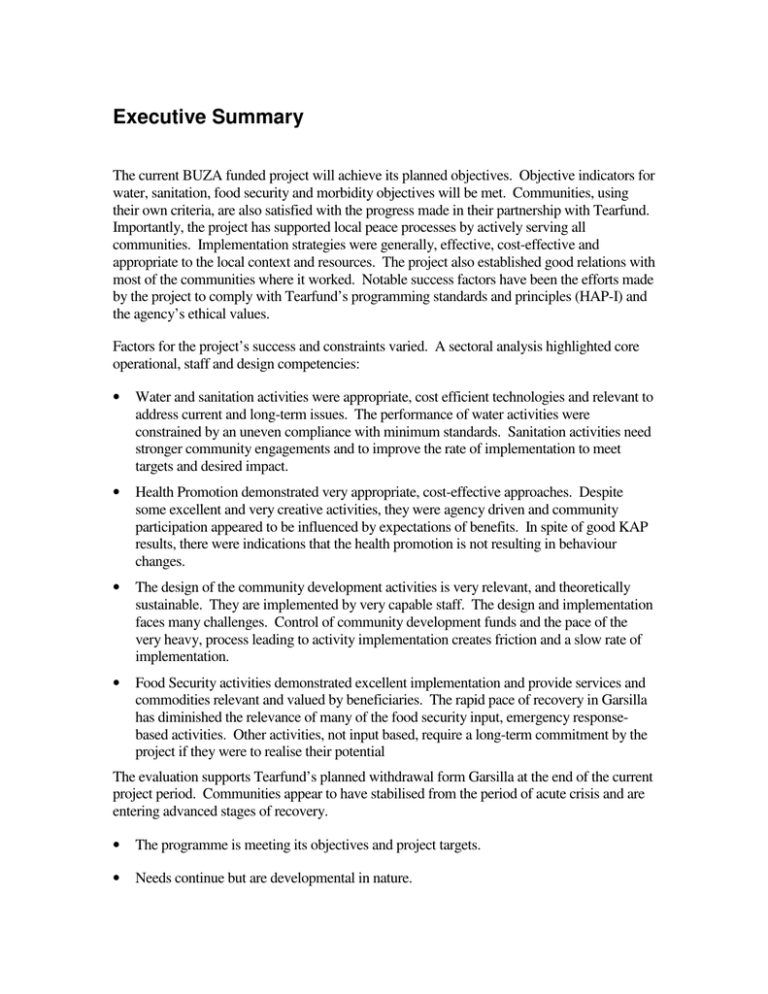
Executive Summary The current BUZA funded project will achieve its planned objectives. Objective indicators for water, sanitation, food security and morbidity objectives will be met. Communities, using their own criteria, are also satisfied with the progress made in their partnership with Tearfund. Importantly, the project has supported local peace processes by actively serving all communities. Implementation strategies were generally, effective, cost-effective and appropriate to the local context and resources. The project also established good relations with most of the communities where it worked. Notable success factors have been the efforts made by the project to comply with Tearfund’s programming standards and principles (HAP-I) and the agency’s ethical values. Factors for the project’s success and constraints varied. A sectoral analysis highlighted core operational, staff and design competencies: • Water and sanitation activities were appropriate, cost efficient technologies and relevant to address current and long-term issues. The performance of water activities were constrained by an uneven compliance with minimum standards. Sanitation activities need stronger community engagements and to improve the rate of implementation to meet targets and desired impact. • Health Promotion demonstrated very appropriate, cost-effective approaches. Despite some excellent and very creative activities, they were agency driven and community participation appeared to be influenced by expectations of benefits. In spite of good KAP results, there were indications that the health promotion is not resulting in behaviour changes. • The design of the community development activities is very relevant, and theoretically sustainable. They are implemented by very capable staff. The design and implementation faces many challenges. Control of community development funds and the pace of the very heavy, process leading to activity implementation creates friction and a slow rate of implementation. • Food Security activities demonstrated excellent implementation and provide services and commodities relevant and valued by beneficiaries. The rapid pace of recovery in Garsilla has diminished the relevance of many of the food security input, emergency responsebased activities. Other activities, not input based, require a long-term commitment by the project if they were to realise their potential The evaluation supports Tearfund’s planned withdrawal form Garsilla at the end of the current project period. Communities appear to have stabilised from the period of acute crisis and are entering advanced stages of recovery. • The programme is meeting its objectives and project targets. • Needs continue but are developmental in nature. • The programmatic priority should be to consolidate activities. • Tearfund has planned an exit in 2010. • Extending the project would necessitate developmental modalities and long-term time frames. The project will deliver on its current objectives. Coverage of sanitation facilities and access to safe water is good. Diarrhoea prevalence is stable. Household crop production has increased significantly, as has local crop production generally. The cumulative value of current activities together with Tearfund’s activities from earlier phases of the programme will leave a significant footprint in these communities. Meeting objectives is attributable to motivated staff and capacity to implement quality programming in extreme conditions. As well, the agency’s Christian values and broader principles is a very unique and important element of the current programming success. Whether international staff or Sudanese, Christian or Muslim, they all share a sincere conviction to serve communities affected by the current crisis. It is a uniquely professional and principled working environment and one which derives quality results on the ground. Needs continue to exist in Garsilla but they are developmental in nature. It is difficult to mark the point where in a chronic crisis a community moves from acute emergency to stabilisation and then recovery. Site visits and discussions with beneficiaries suggest that the period of stabilisation has passed and issues of advanced recovery are more relevant. Evidence of a recovering rural economy was observed in homes, villages and markets. Emergency response activities do not relate to these types of needs. The programmatic priority for next year should be to consolidate the programme’s four year investment in Garsilla. Current activities may be decreasingly relevant to the current context, but still provide value to communities. No changes to activities or implementational strategies were felt to be necessary. Years of investment in Garsilla have generated solid relations with communities and have developed excellent internal finance, logistical and administrative systems, that will enable quality programming to finish with the satisfaction of reaching their objectives. Consolidation priorities will vary according to the sector of activity. The most urgent project requirement is that WATSAN should address basic quality issues on water points already installed. These quality issues are non-negotiable and minimum standards must be met. Health behaviours were felt to be unchanged even if knowledge had increased. Integration between Health Promotion, WATSAN and Food Security messages is an opportunity for greater impact without changing activities. Including the poor through modifications to seed and tree interventions will provide more equity, without changing the intervention itself. These modifications should not undermine a strong community targeting mechanisms which are a core success factor. Continuing efforts to delivering project activities to all communities can reduce frictions in Garsilla area. Tearfund’s Garsilla strategy document has planned an exit in 2010. It recognises the need to define a point at which the mandate of DMT ceases. Similarly, the North Sudan Programme Capacities Review emphasised development vs. relief priorities in the Garsilla programme. Several programme activities are deliberate attempts to bridge transition to recovery. Concerns by staff about the vagaries of security conditions make them uncomfortable to discuss exiting. It is true, that if there were to be a resumption of hostilities, the programmes current investment in local capacity and operational presence is an excellent for of preparedness and response potential. While threat of insecurity is real in Garsilla, that threat is perceived to be less imminent than in Ed Daein, Beida or many other locations in Darfur. In response Tearfund is going ahead with the planned exit at the end or the current project cycle focusing on consolidating activities, handover and capacity building.
